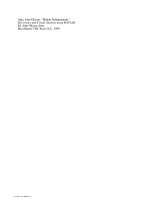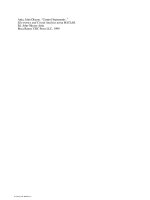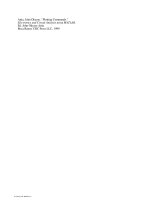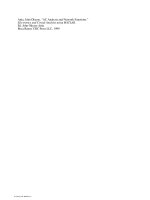Electronics and Circuit Analysis Using MATLAB
Bạn đang xem bản rút gọn của tài liệu. Xem và tải ngay bản đầy đủ của tài liệu tại đây (2.57 MB, 400 trang )
Attia, John Okyere. “FrontMatter.”
Electronics and Circuit Analysis using MATLAB.
Ed. John Okyere Attia
Boca Raton: CRC Press LLC, 1999
© 1999 by CRC PRESS LLC
ELECTRONICS
and CIRCUIT
ANALYSIS
using MATLAB
JOHN O. ATTIA
Department of Electrical Engineering
Prairie View A&M University
Boca Raton London New York Washington, D.C.
CRC Press
© 1999 CRC Press LLC
© 1999 CRC Press LLC
This book contains information obtained from authentic and highly regarded sources.
Reprinted material is quoted with permission, and sources are indicated. A wide variety of
references are listed. Reasonable efforts have been made to publish reliable data and
information, but the author and the publisher cannot assume responsibility for the validity
of all materials or for the consequences of their use.
Neither this book nor any part may be reproduced or transmitted in any form or by any
means, electronic or mechanical, including photocopying, microfilming, and recording, or
by any information storage or retrieval system, without prior permission in writing from
the publisher.
The consent of CRC Press LLC does not extend to copying for general distribution, for
promotion, for creating new works, or for resale. Specific permission must be obtained in
writing from CRC Press LLC for such copying.
Direct all inquiries to CRC Press LLC, 2000 Corporate Blvd. N.W. , Boca Raton, Florida
33431.
Trademark Notice:
Product or corporate names may be trademarks or registered trade-
marks, and are used only for identification and explanation, without intent to infringe.
© 1999 by CRC Press LLC
No claim to original U.S. Government works
International Standard Book Number 0-8493-1176-4
Library of Congress Card Number 98-46071
Printed in the United States of America 1 2 3 4 5 6 7 8 9 0
Printed on acid-free paper
Library of Congress Cataloging-in-Publication Data
Attia, John Okyere.
Electronics and circuit analysis using MATLAB / John Okyere Attia
p. cm.
Includes bibliographical references and index.
ISBN 0-8493-1176-4 (alk. paper)
1. Electronics--Data processing. 2. Electric circuit analysis-
-Data processing. 3. MATLAB (Computer file) I Title.
TK7835.A88 1999
621.381’0285--dc21
CIP
98-46071
© 1999 CRC Press LLC
© 1999 CRC Press LLC
PREFACE
MATLAB is a numeric computation software for engineering and scientific
calculations. MATLAB is increasingly being used by students, researchers,
practicing engineers and technicians. The causes of MATLAB popularity are
legion. Among them are its iterative mode of operation, built-in functions,
simple programming, rich set of graphing facilities, possibilities for writing
additional functions, and its extensive toolboxes.
The goals of writing this book are (1) to provide the reader with simple, easy,
hands-on introduction to MATLAB; (2) to demonstrate the use of MATLAB for
solving electronics problems; (3) to show the various ways MATLAB can be
used to solve circuit analysis problems; and (4) to show the flexibility of
MATLAB for solving general engineering and scientific problems.
Audience
The book can be used by students, professional engineers and technicians. The
first part of the book can be used as a primer to MATLAB. It will be useful to
all students and professionals who want a basic introduction to MATLAB.
Parts 2 and 3 are for electrical and electrical engineering technology students and
professionals who want to use MATLAB to explore the characteristics of
semiconductor devices and the application of MATLAB for analysis and
design of electrical and electronic circuits and systems.
Organization
The book is divided into three parts: Introduction to MATLAB, Circuit analysis
applications using MATLAB, and electronics applications with MATLAB. It is
recommended that the reader work through and experiment with the examples at
a computer while reading Chapters 1, 2, and 3. The hands-on approach is one of
the best ways of learning MATLAB.
Part II consists of Chapters 4 to 8. This part covers the applications of
MATLAB in circuit analysis. The topics covered in Part II are dc analysis,
transient analysis, alternating current analysis, and Fourier analysis. In addition,
two-port networks are covered. I have briefly covered the underlying theory and
concepts, not with the aim of writing a textbook on circuit analysis and
electronics. Selected problems in circuit analysis have been solved using
MATLAB.
© 1999 CRC Press LLC
© 1999 CRC Press LLC
Part III includes Chapters 9, 10, 11 and 12. The topics discussed in this part are
diodes, semiconductor physics, operational amplifiers and transistor circuits.
Application of MATLAB for problem solving in electronics is discussed.
Extensive examples showing the use of MATLAB for solving problems in
electronics are presented.
Each chapter has its own bibliography and exercises.
Text Diskette
Since the text contains a large number of examples that illustrate electronics
and circuit analysis principles and applications with MATLAB, a diskette is
included that contains all the examples in the book. The reader can run the
examples without having to enter the commands. The examples can also be
modified to suit the needs of the reader.
Acknowledgments
I appreciate the suggestions and comments from a number of reviewers including
Dr. Murari Kejariwal, Dr. Reginald Perry, Dr. Richard Wilkins, Mr. Warsame
Ali, Mr. Anowarul Huq and Mr. John Abbey. Their frank and positive
criticisms led to considerable improvement of this work.
I am grateful to Mr. Zhong You for typing and running some of the MATLAB
programs in this book and I am also grateful to Mr. Carl Easton and Mr. Url
Woods for drawing the circuit diagrams found in the text. I thank Ms. Debbie
Hawkins and Cheryl Wright who typed several parts of this book. I am
appreciative of Ms. Judith Hansen for her editing services. Special thanks go
Ms. Nora Konopka, at CRC Press, who took an early interest in this book and
offered me any assistance I needed to get it completed. I thank Ms. Mimi
Williams, at CRC Press, for thoroughly proofreading the manuscript.
The questions and comments from electrical engineering students at Prairie
View A&M University led to rewriting some sections of this work. Special
thanks go to the students who used various drafts of this book and provided
useful comments.
A final note of gratitude goes to my wife, Christine N. Okyere, who encouraged
me to finish the book in record time. With equanimity and understanding, she
stood by me during the endless hours I spent writing.
© 1999 CRC Press LLC
© 1999 CRC Press LLC
DEDICATION
Dedicated to my family members
Christine, John II and Angela
for
their unfailing love, support and encouragement
© 1999 CRC Press LLC
© 1999 CRC Press LLC
CONTENTS
CHAPTER ONE MATLAB FUNDAMENTALS
1.1 MATLAB BASIC OPERATIONS
1.2 MATRIX OPERATIONS
1.3 ARRAY OPERATIONS
1.4 COMPLEX NUMBERS
1.5 THE COLON SYMBOL ( : )
1.6 M-FILES
1.6.1 Script files
1.6.2 Function files
SELECTED BIBLIOGRAPHY
EXERCISES
CHAPTER TWO PLOTTING COMMANDS
2.1 GRAPH FUNCTIONS
2.2 X-Y PLOTS AND ANNOTATIONS
2.3 LOGARITHMIC AND POLAR PLOTS
2.4 SCREEN CONTROL
SELECTED BIBLIOGRAPHY
EXERCISES
CHAPTER THREE CONTROL STATEMENTS
3.1 FOR LOOPS
3.2 IF STATEMENTS
3.3 WHILE LOOP
3.4 INPUT/OUTPUT COMMANDS
SELECTED BIBLIOGRAPHY
EXERCISES
© 1999 CRC Press LLC
© 1999 CRC Press LLC
CHAPTER FOUR DC ANALYSIS
4.1 NODAL ANALYSIS
4.2 LOOP ANALYSIS
4.3 MAXIMUM POWER TRANSFER
4.3.1 MATLAB diff and find Functions
SELECTED BIBLIOGRAPHY
EXERCISES
CHAPTER FIVE TRANSIENT ANALYSIS
5.1 RC NETWORK
5.2 RL NETWORK
5.3 RLC CIRCUIT
5.4 STATE VARIABLE APPROACH
5.4.1 MATLAB ode functions
SELECTED BIBLIOGRAPHY
EXERCISES
CHAPTER SIX AC ANALYSIS AND NETWORK
FUNCTIONS
6.1 STEADY STATE AC POWER
6.1.1 MATLAB functions quad and quad8
6.2 SINGLE- AND THREE-PHASE AC CIRCUITS
6.3 NETWORK CHARACTERISTICS
6.3.1 MATLAB functions roots, residue and
polyval
6.4 FREQUENCY RESPONSE
6.4.1 MATLAB Function freqs
SELECTED BIBLIOGRAPHY
EXERCISES
© 1999 CRC Press LLC
© 1999 CRC Press LLC
CHAPTER SEVEN TWO-PORT NETWORKS
7.1 TWO-PORT NETWORK REPRESENTATIONS
7.1.1 z-parameters
7.1.2 y-parameters
7.1.3 h-parameters
7.1.4 Transmission parameters
7.2 INTERCONNECTION OF TWO-PORT
NETWORKS
7.3 TERMINATED TWO-PORT NETWORKS
SELECTED BIBLIOGRAPHY
EXERCISES
CHAPTER EIGHT FOURIER ANALYSIS
8.1 FOURIER SERIES
8.2 FOURIER TRANSFORMS
8.2.1 Properties of Fourier transform
8.3 DISCRETE AND FAST FOURIER TRANSFORMS
8.3.1 MATLAB function fft
SELECTED BIBLIOGRAPHY
EXERCISES
CHAPTER NINE DIODES
9.1 DIODE CHARACTERISTICS
9.1.1 Forward-biased region
9.1.2 MATLAB function polyfit
9.1.3 Temperature effects
9.2 ANALYSIS OF DIODE CIRCUITS
9.3 HALF-WAVE RECTIFIER
9.3.1 MATLAB function fzero
9.4 FULL-WAVE RECTIFICATION
9.5 ZENER DIODE VOLTAGE REGULATOR
CIRCUIT
SELECTED BIBLIOGRAPHY
EXERCISES
© 1999 CRC Press LLC
© 1999 CRC Press LLC
10.1 INTRINSIC SEMICONDUCTOR
10.1.1 Energy bands
10.1.2 Mobile carriers
10.2 EXTRINSIC SEMICONDUCTOR
10.2.1 Electron and hole concentrations
10.2.2 Fermi level
10.2.3 Current density and mobility
10.3 PN JUNCTION: CONTACT POTENTIAL,
JUNCTION CURRENT
10.3.1 Contact potential
10.3.2 Junction current
10.4 DEPLETION AND DIFFUSION
CAPACITANCES
10.4.1 Depletion capacitance
10.4.2 Diffusion capacitance
10.5 BREAKDOWN VOLTAGES OF PN JUNCTIONS
REFERENCES
EXERCISES
CHAPTER ELEVEN OPERATIONAL AMPLIFIERS
11.1 PROPERTIES OF THE OP AMP
11.2 INVERTING CONFIGURATION
11.3 NON-INVERTING CONFIGURATION
11.4 EFFECT OF FINITE OPEN-LOOP GAIN
11.5 FREQUENCY RESPONSE OF OP AMPS
11.6 SLEW RATE AND FULL-POWER
BANDWIDTH
11.7 COMMON-MODE REJECTION
SELECTED BIBLIOGRAPHY
EXERCISES
CHAPTER TWELVE TRANSISTOR CIRCUITS
12.1 BIPOLAR JUNCTION TRANSISTORS
12.2 BIASING OF BJT DISCRETE CIRCUITS
12.2.1 Self-bias circuit
12.2.2 Bias stability
12.3 INTEGRATED CIRCUIT BIASING
12.3.1 Simple current mirror
CHAPTER TEN SEMICONDUCTOR PHYSICS
© 1999 CRC Press LLC
© 1999 CRC Press LLC
12.3.2 Wilson current source
12.4 FREQUENCY RESPONSE OF
COMMON EMITTER AMPLIFIER
12.5 MOSFET CHARACTERISTICS
12.6 BIASING OF MOSFET CIRCUITS
12.7 FREQUENCY RESPONSE OF
COMMON-SOURCE AMPLIFIER
SELECTED BIBLIOGRAPHY
EXERCISES
© 1999 CRC Press LLC
© 1999 CRC Press LLC
LIST OF EXAMPLES IN TEXT
CHAPTER ONE MATLAB FUNDAMENTALS
EXAMPLE
DESCRIPTION
1.1
Power Dissipation in a Resistor
1.2
Complex Number Representation
1.3
Equivalent Resistance
1.4
Quadratic Equation
CHAPTER TWO PLOTTING COMMANDS
EXAMPLE
DESCRIPTION
2.1 Voltage and Current of an RL Circuit
2.2
Gain versus Frequency of an RC Amplifier
2.3
Polar Plot of a Complex Number
CHAPTER THREE CONTROL STATEMENTS
EXAMPLE
DESCRIPTION
3.1
Horizontal and Vertical Displacement
3.2
A 3-bit A/D Converter
3.3
Consecutive Integer Numbers
© 1999 CRC Press LLC
© 1999 CRC Press LLC
EXAMPLE
DESCRIPTION
4.1
Nodal Voltages of a Simple Circuit
4.2
Circuit with Dependent and Independent
Sources
4.3
Loop Analysis of a Bridge Circuit
4.4 Power Dissipation and Source Current
4.5 Nodal Voltage Circuit with Dependent Sources
4.6 Maximum Power Dissipation
CHAPTER FIVE TRANSIENT ANALYSIS
EXAMPLE
DESCRIPTION
5.1 Charging of a Capacitor with Different Time
Constants
5.2
Charging and Discharging of a Capacitor
5.3 Current Flowing through Inductor of RL
Circuit
5.4
Current Flowing through a Series RLC Circuit
5.5
Voltage across a Parallel RLC Circuit
5.6
State Variable Approach to RC Circuit
5.7
State Variable Approach to an RLC Circuit
Analysis
5.8 State Variable Analysis of a Network
CHAPTER FOUR DC ANALYSIS
© 1999 CRC Press LLC
© 1999 CRC Press LLC
EXAMPLE
DESCRIPTION
6.1
Power Calculations of One-port Network
6.2 AC Voltage of an RLC Circuit
6.3
AC Current and Voltage of a Circuit with Two
Sources
6.4
Unbalanced Wye-wye Connection
6.5
Network Function, Poles and Zeros of a Circuit
6.6
Inverse Laplace Transform
6.7
Magnitude and Phase Response of an RLC
Circuit
CHAPTER SEVEN TWO-PORT NETWORKS
EXAMPLE
DESCRIPTION
7.1 z-parameters of T-Network
7.2
y-parameters of Pi-Network
7.3
y-parameters of Field Effect Transistor
7.4 h-parameters of Bipolar Junction Transistor
7.5
Transmission Parameters of a Simple
Impedance Network
7.6
Transmission Parameters of a Simple
Admittance Network
7.7
y-parameters of Bridge T-Network
7.8 Transmission Parameters of a Simple
Cascaded Network
7.9
Transmission Parameters of a Cascaded System
7.10
z - parameters and Magnitude Responses of an
Active Lowpass Filter
CHAPTER SIX AC ANALYSIS AND NETWORK FUNCTIONS
© 1999 CRC Press LLC
© 1999 CRC Press LLC
EXAMPLE
DESCRIPTION
8.1
Fourier Series Expansion of a Square Wave
8.2
Amplitude and Phase Spectrum of Full-wave
Rectifier Waveform
8.3
Synthesis of a Periodic Exponential Signal
8.4
DFT and FFT of a Sequence
8.5
Fourier Transform and DFT of a Damped
Exponential Sinusoid
8.6 Power Spectral Density of a Noisy Signal
CHAPTER NINE DIODES
EXAMPLE
DESCRIPTION
9.1
Determination of Diode Parameters from Data
9.2
I-V characteristic of a Diode at Different
Temperatures
9.3
Operating Point of a Diode Using Graphical
Techniques
9.4
Operating Point of a Diode using Iterative
Technique
9.5
Battery Charging Circuit – Current, Conduction
Angle and Peak Current
9.6
Capacitor Smoothing Circuit – Calculation of
Critical Times
9.7
Full-wave Rectifier – Ripple Voltage, Dc
Output Voltage, Discharge Time and Period of
Ripple
9.8
A Zener Diode Voltage Regulator
CHAPTER EIGHT FOURIER ANALYSIS
© 1999 CRC Press LLC
© 1999 CRC Press LLC
EXAMPLE
DESCRIPTION
10.1 Electron Concentration versus Temperature
10.2
Minority Carriers in Doped Semiconductor
10.3
Electron and Hole Mobilities versus Doping
Concentration
10.4 Resistivity versus Doping
10.5
Junction Potential versus Voltage
10.6
Effects of Temperature on Reverse Saturation
Current
10.7
Depletion Capacitance of a PN Junction
10.8
Diffusion and Depletion Capacitance as a
Function of Voltage
10.9 Effect of Doping Concentration on the
Breakdown Voltage of a PN Junction
CHAPTER ELEVEN OPERATIONAL AMPLIFIERS
EXAMPLE
DESCRIPTION
11.1 Frequency Response of Miller Integrator
11.2
Transfer function, Poles, and Zeros of a Non-
inverting Op Amp Circuit
11.3
Effect of Finite Open Loop Gain
11.4
Open Loop Gain Characteristics of an Op Amp
11.5
Effect of Closed Loop Gain on the Frequency
Response of an Op Amp
11.6
Output Voltage versus Full-power Bandwidth
CHAPTER TEN SEMICONDUCTOR PHYSICS
11.7
Effect of CMRR on the Closed Loop Gain
© 1999 CRC Press LLC
© 1999 CRC Press LLC
12.2 Output Characteristics of an NPN Transistor
12.3
Self-Bias Circuit – Stability Factors and
Collector Current as a Function of
Temperature
12.4
Comparison of Simple Current Mirror and
Wilson Current Source
12.5
Frequency Response of a Common Emitter
Amplifier
12.6
I-V Characteristics of NMOS
12.7
Operating Point Calculation of NMOS Biasing
Circuit
12.8
Voltage and Current Calculations for a
MOSFET Current mirror
12.9 Common-source Amplifier Gain, Cut-off
Frequencies and Bandwidth
CHAPTER TWELVE TRANSISTOR CIRCUITS
EXAMPLE
DESCRIPTION
12.1 Input Characteristics of a BJT
© 1999 CRC Press LLC
© 1999 CRC Press LLC
Attia, John Okyere. “Matlab Fundamentals.”
Electronics and Circuit Analysis using MATLAB.
Ed. John Okyere Attia
Boca Raton: CRC Press LLC, 1999
© 1999 by CRC PRESS LLC
CHAPTER ONE
MATLAB FUNDAMENTALS
MATLAB is a numeric computation software for engineering and scientific
calculations. The name MATLAB stands for MATRIX LABORATORY.
MATLAB is primarily a tool for matrix computations. It was developed by
John Little and Cleve Moler of MathWorks, Inc. MATLAB was originally
written to provide easy access to the matrix computation software packages
LINPACK and EISPACK.
MATLAB is a high-level language whose basic data type is a matrix that does
not require dimensioning. There is no compilation and linking as is done in
high-level languages, such as C or FORTRAN. Computer solutions in
MATLAB seem to be much quicker than those of a high-level language such
as C or FORTRAN. All computations are performed in complex-valued dou-
ble precision arithmetic to guarantee high accuracy.
MATLAB has a rich set of plotting capabilities. The graphics are integrated in
MATLAB. Since MATLAB is also a programming environment, a user can
extend the functional capabilities of MATLAB by writing new modules.
MATLAB has a large collection of toolboxes in a variety of domains. Some
examples of MATLAB toolboxes are control system, signal processing, neural
network, image processing, and system identification. The toolboxes consist
of functions that can be used to perform computations in a specific domain.
1.1 MATLAB BASIC OPERATIONS
When MATLAB is invoked, the command window will display the prompt >>.
MATLAB is then ready for entering data or executing commands. To quit
MATLAB, type the command
exit or quit
MATLAB has on-line help. To see the list of MATLAB’s help facility, type
help
The help command followed by a function name is used to obtain informa-
tion on a specific MATLAB function. For example, to obtain information on
the use of fast Fourier transform function, fft, one can type the command
© 1999 CRC Press LLC
© 1999 CRC Press LLC
help fft
The basic data object in MATLAB is a rectangular numerical matrix with real
or complex elements. Scalars are thought of as a 1-by-1 matrix. Vectors are
considered as matrices with a row or column. MATLAB has no dimension
statement or type declarations. Storage of data and variables is allocated
automatically once the data and variables are used.
MATLAB statements are normally of the form:
variable = expression
Expressions typed by the user are interpreted and immediately evaluated by the
MATLAB system. If a MATLAB statement ends with a semicolon, MATLAB
evaluates the statement but suppresses the display of the results. MATLAB
is also capable of executing a number of commands that are stored in a file.
This will be discussed in Section 1.6. A matrix
A =
123
234
345
may be entered as follows:
A = [1 2 3; 2 3 4; 3 4 5];
Note that the matrix entries must be surrounded by brackets [ ] with row
elements separated by blanks or by commas. The end of each row, with the
exception of the last row, is indicated by a semicolon. A matrix A can also be
entered across three input lines as
A = [ 1 2 3
2 3 4
3 4 5];
In this case, the carriage returns replace the semicolons. A row vector B with
four elements
B = [ 6 9 12 15 18 ]
can be entered in MATLAB as
© 1999 CRC Press LLC
© 1999 CRC Press LLC
B = [6 9 12 15 18];
or
B = [6 , 9,12,15,18]
For readability, it is better to use spaces rather than commas between the ele-
ments. The row vector B can be turned into a column vector by transposition,
which is obtained by typing
C = B’
The above results in
C =
6
9
12
15
18
Other ways of entering the column vector C are
C = [6
9
12
15
18]
or
C = [6; 9; 12; 15; 18]
MATLAB is case sensitive in naming variables, commands and functions.
Thus b and B are not the same variable. If you do not want MATLAB to be
case sensitive, you can use the command
casesen off
To obtain the size of a specific variable, type size ( ). For example, to find the
size of matrix A, you can execute the following command:
size(A)
© 1999 CRC Press LLC
© 1999 CRC Press LLC
The result will be a row vector with two entries. The first is the number of
rows in A, the second the number of columns in A.
To find the list of variables that have been used in a MATLAB session, type
the command
whos
There will be a display of variable names and dimensions. Table 1.1 shows
the display of the variables that have been used so far in this book:
Table 1.1
Display of an output of whos command
Name
Size Elements Byte Density Complex
A 3 by 3 9 72 Full No
B 1 by 5 5 40 Full No
C 5 by 1 5 40 Full No
ans 1 by 2 2 16 Full No
The grand total is 21 elements using 168 bytes.
Table 1.2 shows additional MATLAB commands to get one started on
MATLAB. Detailed descriptions and usages of the commands can be obtained
from the MATLAB help facility or from MATLAB manuals.
Table 1.2
Some Basic MATLAB Commands
Command Description
%
Comments. Everything appearing after % com-
mand is not executed.
demo
Access on-line demo programs
length
Length of a matrix
clear
Clears the variables or functions from workspace
clc
Clears the command window during a work session
clg
Clears graphic window
diary
Saves a session in a disk, possibly for printing at a
later date
© 1999 CRC Press LLC
© 1999 CRC Press LLC
1.2 MATRIX OPERATIONS
The basic matrix operations are addition(+), subtraction(-), multiplication (*),
and conjugate transpose(‘) of matrices. In addition to the above basic opera-
tions, MATLAB has two forms of matrix division: the left inverse operator \
or the right inverse operator /.
Matrices of the same dimension may be subtracted or added. Thus if E and F
are entered in MATLAB as
E = [7 2 3; 4 3 6; 8 1 5];
F = [1 4 2; 6 7 5; 1 9 1];
and
G = E - F
H = E + F
then, matrices G and H will appear on the screen as
G =
6 -2 1
-2 -4 1
7 -8 4
H =
8 6 5
10 10 11
9 10 6
A scalar (1-by-1 matrix) may be added to or subtracted from a matrix. In this
particular case, the scalar is added to or subtracted from all the elements of an-
other matrix. For example,
J = H + 1
gives
J =
9 7 6
11 11 12
10 11 7
Matrix multiplication is defined provided the inner dimensions of the two op-
erands are the same. Thus, if X is an n-by-m matrix and Y is i-by-j matrix,
© 1999 CRC Press LLC
© 1999 CRC Press LLC
X*Y is defined provided m is equal to i. Since E and F are 3-by-3 matrices,
the product
Q = E*F
results as
Q =
22 69 27
28 91 29
19 84 26
Any matrix can be multiplied by a scalar. For example,
2*Q
gives
ans =
44 138 54
56 182 58
38 168 52
Note that if a variable name and the “=” sign are omitted, a variable name ans
is automatically created.
Matrix division can either be the left division operator \ or the right division
operator /. The right division a/b, for instance, is algebraically equivalent to
a
b
while the left division a\b is algebraically equivalent to
b
a
.
If
ZI V*
=
and Z is non-singular, the left division, Z\V is equivalent to
MATLAB expression
IinvZV
=
()*
where inv is the MATLAB function for obtaining the inverse of a matrix. The
right division denoted by V/Z is equivalent to the MATLAB expression
IVinvZ
=
*()
There are MATLAB functions that can be used to produce special matrices.
Examples are given in Table 1.3.
© 1999 CRC Press LLC
© 1999 CRC Press LLC









